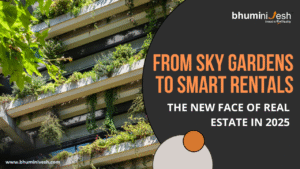

The idea of eco-friendly living has become very popular in the modern world, where environmental issues are of the utmost importance. Eco-friendly estates provide a special fusion of comfort, luxury, and environmental consciousness. The goal of these improvements is to maximize the quality of life for inhabitants while minimizing their ecological impact.
What Makes an Estate Eco-Friendly?
Several sustainable strategies are incorporated into an eco-friendly estate:
Sustainable Construction Methods:
Eco-friendly Materials: Making use of materials like bamboo, repurposed wood, and natural stone that have little effect on the environment. These materials frequently have a smaller carbon impact and require less energy to generate.
Energy-Efficient Design: Using techniques including airtight construction, effective window placement, and enough insulation to lower heating and cooling energy usage.
Renewable Energy Integration: Using renewable energy sources to provide clean electricity, such as geothermal systems, wind turbines, or solar panels.
Green Living:
Water Conservation: Using methods to cut down on water use, such as xeriscaping (drought-tolerant landscaping), low-flow fixtures, and rainwater harvesting.
Garbage Reduction: To lessen the negative effects of garbage disposal on the environment, recycling, composting, and waste reduction initiatives are encouraged.
Sustainable Transportation: Promoting walking, bicycling, public transportation, and electric cars as ways to cut carbon emissions.

Eco-Friendly Real Estate Developments
Community Planning: Creating projects that put an emphasis on green areas, pathways for pedestrians, and community facilities in order to promote a feeling of community and lessen dependency on automobiles.
Green Certifications: To confirm the development’s sustainability, look for certifications such as BREEAM (Building Research Establishment Environmental Assessment Method) or LEED (Leadership in Energy and Environmental Design).
Long-Term Sustainability: Taking into account the development’s long-term effects on the environment, taking into account elements like energy efficiency, waste management, and water conservation.
Benefits of Living in an Eco-Friendly Estate
Living in an eco-friendly community has several advantages, including better air quality and less exposure to dangerous toxins.
Lower Utility Costs: Renewable energy sources and energy-efficient architecture can drastically cut utility costs.
Benefits to the Environment: Reducing carbon emissions and promoting a more sustainable future.
Improved Quality of Life: tranquil surroundings, green space accessibility, and a feeling of belonging.
Higher Property Value: Because eco-friendly homes are sustainable and desirable, their value tends to increase with time.

Selecting Your Green Sanctuary
Take into account the following elements while choosing an eco-friendly estate:
Commitment of the Developer: Investigate developers who have a strong dedication to sustainability and a history of environmentally favorable initiatives.
Certifications: Seek out properties that have earned certifications such as LEED or BREEAM, which guarantee adherence to strict environmental guidelines.
Location: Take into account how close the estate is to facilities, the bus, and green areas.
Community Features: Evaluate whether walking trails, community gardens, and other environmentally friendly features are available.
Future-proofing: Make sure the estate is built to accommodate upcoming environmental issues and developments in technology.
Conclusion :
You’re investing in a healthier, more sustainable future when you decide to live in an eco-friendly community rather than just a piece of real estate. For individuals looking for a more eco-friendly way of living, these developments present a distinctive fusion of comfort, elegance, and environmental responsibility. Accept the balance between nature and contemporary life and help create a more sustainable world.


🌄 Himachal is Not for Sale: Understanding Section 118 and Why It Matters


From Sky Gardens to Smart Rentals: The New Face of Real Estate in 2025



